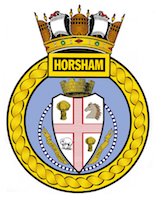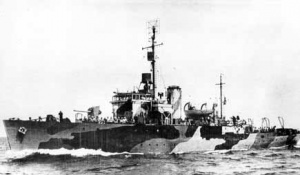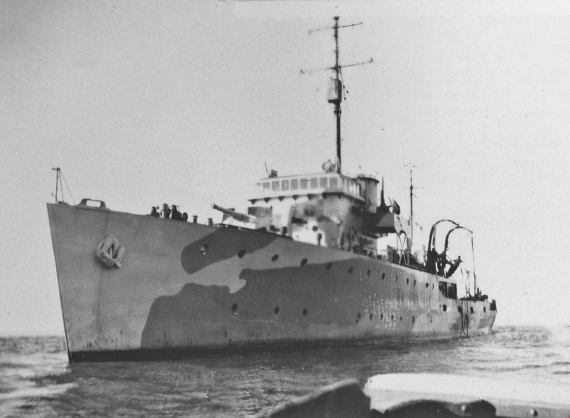HMAS Horsham (I)
| Pennant |
J235 |
|---|---|
| Builder |
Melbourne Harbour Trust, Williamstown |
| Laid Down |
26 June 1941 |
| Launched |
16 May 1942 |
| Launched by |
Mrs AD Mackenzie, wife of Chairman of Melbourne Harbour Trust |
| Commissioned |
18 November 1942 |
| Decommissioned |
17 November 1945 |
| Dimensions & Displacement | |
| Displacement | 650 tons |
| Length | 186 feet |
| Beam | 31 feet |
| Draught | 8 feet 6 inches |
| Performance | |
| Speed | 15.5 knots |
| Complement | |
| Crew | 85 |
| Propulsion | |
| Machinery | Triple expansion, 2 shafts |
| Horsepower | 2000 |
| Armament | |
| Guns |
|

HMAS Horsham was one of sixty Australian Minesweepers (commonly known as corvettes) built during World War II in Australian shipyards as part of the Commonwealth Government’s wartime shipbuilding programme. Twenty were built on Admiralty order but commissioned by the Royal Australian Navy. Thirty six (including Horsham) were built for the Royal Australian Navy and four for the Indian Navy.
HMAS Horsham was laid down at Melbourne Harbour Trust, Williamstown, Melbourne, Victoria on 26 June 1941. She was launched on 16 May 1942 by Mrs AD Mackenzie, wife of Chairman of Melbourne Harbour Trust and was the first RAN warship to carry the name of the regional city in the Wimmera region of western Victoria.
HMAS Horsham commissioned at Melbourne on 18 November 1942 under the command of Lieutenant William Newby RANR(S).
On completion of trials in late 1942 Horsham sailed to Western Australia and was assigned to the Fremantle command as an anti-submarine patrol vessel on 1 January 1943. She operated from Fremantle for the next 20 months conducting anti-submarine patrols, training exercises with Allied submarines (that were based at Fremantle) and occasional convoy escort duties along the Western Australian coast as far north as Exmouth and Broome. In August 1944 she proceeded to Darwin to operate as a survey ship and in November conducted a short patrol in the Timor Sea to inspect Cartier Island. She remained based at Darwin, except for a period refitting at Fremantle during February-April 1945, until the end of hostilities.
Horsham was part of a significant Australian and Dutch naval force that arrived at Kupang, Timor on 11 September 1945 to enforce the surrender of Japanese forces on Timor.
Horsham departed Timor on 14 September 1945 and returned to her surveying duties in the Darwin area. She sailed to Fremantle at the end of November and was decommissioned on 17 December 1945 and placed in the Reserve Fleet. During her service she had steamed 95,872 miles and was under way for 11,302 hours.
Horsham was sold as scrap for breaking up to the Hong Kong Delta Shipping Company, Hong Kong, on 8 August 1956.
Note: This video is hosted on YouTube. Department of Defence users will not be able to view this video on the Defence Protected Network.
This cine film has been placed online as part of the Sea Power Centre - Australia's ongoing archival digitisation program.
Further reading
- 'The Corvettes: Forgotten Ships of the Royal Australian Navy' by Iris Nesdale - published by the author, October, 1982.
- 'Corvettes - Little Ships for Big Men' by Frank B Walker - published by Kingfisher Press, NSW, 1996.
- 'The Australian Centenary History of Defence Volume III, The Royal Australian Navy' edited by David Stevens, Oxford University Press, South Melbourne, Victoria, Australia, 2001.












